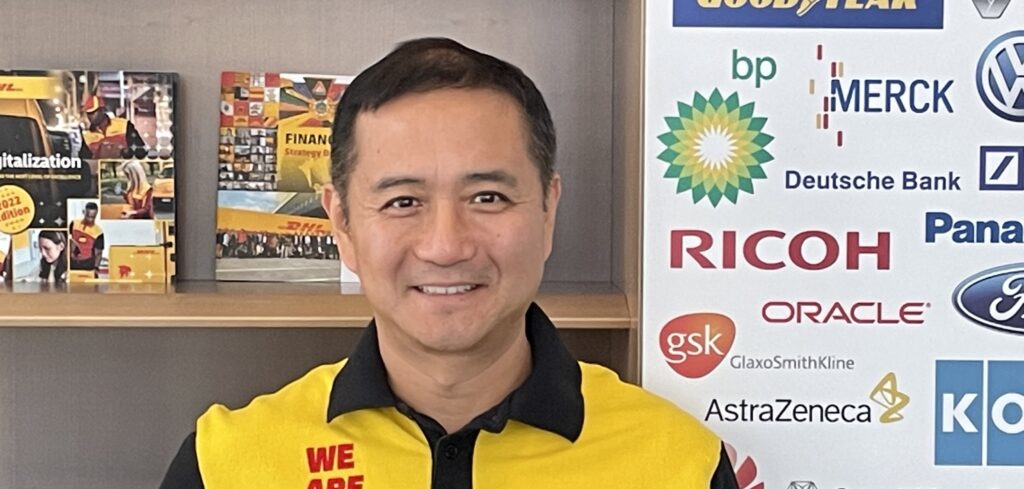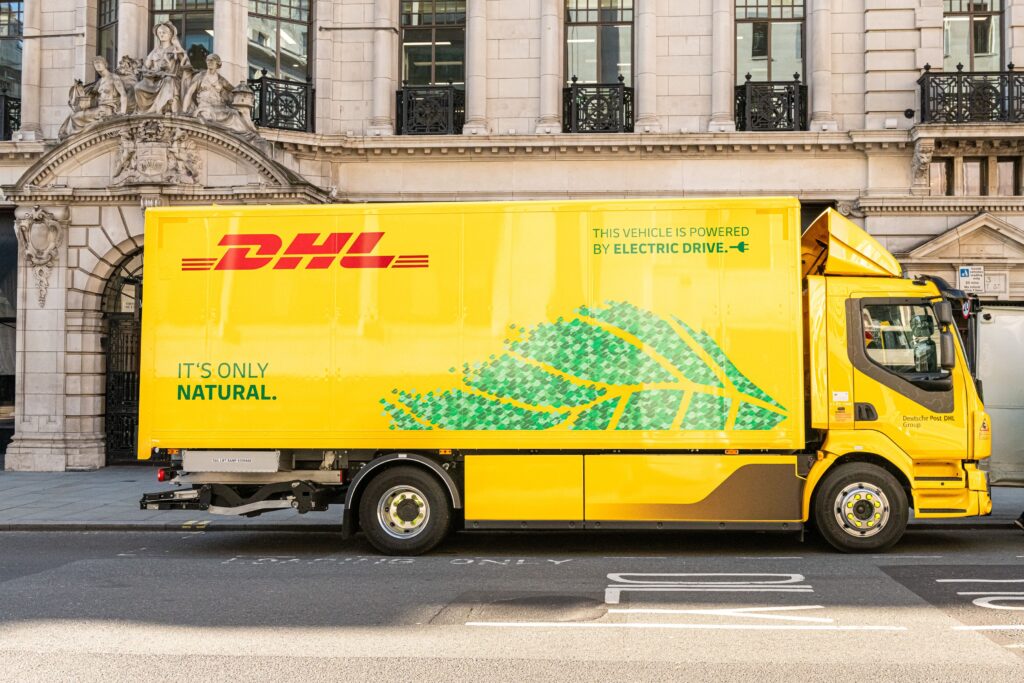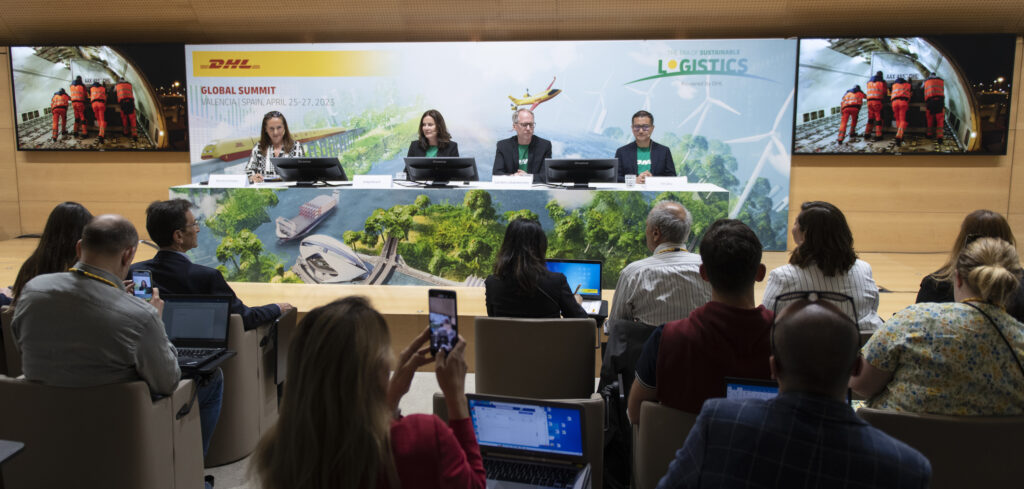Parcel and Postal Technology International speaks with Yin Zou, executive vice president of corporate development at Deutsche Post DHL Group, about the latest addition to its sustainability product line, the GoGreen Dashboard.
Launched in April 2023 at DHL’s first Era of Sustainable Logistics Global Summit (above) in Valencia, Spain, the GoGreen Dashboard has been designed in the spirit of sustainability, accountability and collaboration. The emissions reporting tool enables DPDHL’s customers to view the carbon emissions for all of the group’s business units in a single platform. It enables users to view each unit’s carbon emissions quickly and easily – and is completely free of charge.
This GoGreen Dashboard eliminates the need to access multiple systems and reports, making the reporting process more efficient and streamlined. With this, the company hopes to empower its customers and its own departments with better-informed decision making and, eventually, a reduced carbon footprint. In particular, the group intends to provide transparency for its large cross-divisional customers, according to recognized industry standards like the GLEC Framework and the recently published ISO 14083.
 Zou (above) says, “It’s not only user-friendly and free to access, but it’s also transparent and customizable – so users can select the news they want to have on their dashboards. Customers can enter their own records and even customize their reports with their logos if they wish. Every customer that signs up can get an exact and personalized experience. For instance, one customer might say, ‘I want my total carbon footprint on the front page, and I want the detailed report on the second page.’ You can do that. Another might say, ‘No, I don’t want to put a number on the front, I want to see all the spaces we can improve in.’ It’s great to use. As a product, it’s a self-programing and self-managing solution.”
Zou (above) says, “It’s not only user-friendly and free to access, but it’s also transparent and customizable – so users can select the news they want to have on their dashboards. Customers can enter their own records and even customize their reports with their logos if they wish. Every customer that signs up can get an exact and personalized experience. For instance, one customer might say, ‘I want my total carbon footprint on the front page, and I want the detailed report on the second page.’ You can do that. Another might say, ‘No, I don’t want to put a number on the front, I want to see all the spaces we can improve in.’ It’s great to use. As a product, it’s a self-programing and self-managing solution.”
The executive also underlines the accessibility of the platform, as individuals and commercial partners alike can make use of the comparison view and see DHL’s footprint across its operations. This is to promote visibility and give customers more credible numbers to work from, which, in turn, is intended to support the compilation of accurate reports on Scope 3 emissions (the emissions created from indirect operations). The reports can also be color-coded and made into graphs to show the data visually and make it easy for customers to present data to management and decision makers.
The devil in the detail
 When revealing the solution for the first time, Carsten Luetzenkirchen (right), senior vice president of commercial operations, DHL Customer Solutions and Innovation, highlights the importance of clear yet detailed carbon reporting: “CO2 reporting is a prerequisite to discussing decarbonization. Our group has quite different products: ocean freight, air operations, freight, parcels, mail, shipments and warehouses. Bringing this all together and having frequent, granular and consistent reporting for our customers was quite the challenge for us. We have now mastered this. With the tool, you can show the type and intensity of emissions, and, importantly, you can also subgroup the emissions to help companies see where they are actually releasing harmful emissions.”
When revealing the solution for the first time, Carsten Luetzenkirchen (right), senior vice president of commercial operations, DHL Customer Solutions and Innovation, highlights the importance of clear yet detailed carbon reporting: “CO2 reporting is a prerequisite to discussing decarbonization. Our group has quite different products: ocean freight, air operations, freight, parcels, mail, shipments and warehouses. Bringing this all together and having frequent, granular and consistent reporting for our customers was quite the challenge for us. We have now mastered this. With the tool, you can show the type and intensity of emissions, and, importantly, you can also subgroup the emissions to help companies see where they are actually releasing harmful emissions.”
For example, Deutsche Post DHL Group’s overall carbon footprint came to 36.48 million metric tons in 2022. According to the company’s calculations, 69% of these emissions came from its air operations (namely, its 2,400 daily express flights). Following this, vehicles and road operations – from its 65,000 trucks and 118,500 delivery vehicles – made up approximately 20% of its emissions. The 3,300,000 TEU of sea freight that the group shipped in 2022 formed its third largest source of carbon emissions.
Upon calculating the extent and source of these sizable carbon emissions, the group has committed to spending up to €7bn (US$7.7bn) on decarbonization between now and 2030 – in alternative fuels, the expansion of its zero-emission e-vehicle fleet and in climate-neutral buildings.
Zou says, “This means that regardless of whether the customer or the government is supporting us or not, we will invest at least this amount of our own money to move our sustainability agenda forward.” To tackle its aviation operations specifically, the company aims to increase its use of SAF to more than 30% by 2030. It plans to invest in alternative, fuel-efficient power solution assets while improving flight operations efficiency through the balance of weight and network design. The group also plans to further develop ePlanes (electric airplanes) and ready-to-scale power-to-liquid SAF plants, and use electrification and hydrogen technology to drive down emissions of ground operations at hubs.
 Similarly, to decarbonize its road transportation operations, DPDHL plans to electrify 60% of its last-mile delivery vehicle fleet by 2030, while reducing fuel consumption through permanent network improvements and encouraging subcontractors to adopt green transportation methods through standards, education and incentives to invest in green transportation solutions. Its linehaul transportation division can expect to see more eco-friendly driving training programs as well as a 30% growth in alternative propulsion technologies.
Similarly, to decarbonize its road transportation operations, DPDHL plans to electrify 60% of its last-mile delivery vehicle fleet by 2030, while reducing fuel consumption through permanent network improvements and encouraging subcontractors to adopt green transportation methods through standards, education and incentives to invest in green transportation solutions. Its linehaul transportation division can expect to see more eco-friendly driving training programs as well as a 30% growth in alternative propulsion technologies.
Zou adds, “This will include the ordering of 400 additional gas-powered trucks powered with Bio-CNG for this [linehaul] department.” With these initiatives, the group’s CO2e emissions are to be reduced from 39 million metric tons in 2021 to less than 29 million metric tons by 2030 in line with the requirements of the Science Based Targets Initiative. Furthermore, 30% of the executive board of management’s bonuses will be linked to the company’s sustainability roadmap and its environmental, social and governance (ESG) targets.
Running the numbers
Speaking about the process behind creating the emissions reporting tool, Zou says, “Synthesizing all the data was the biggest challenge. We didn’t want to put out just any number, we wanted to put out something rooted, reportable and accountable.”
According to the company, the industry norm for calculating emissions is based on average usage data. “What we did differently is we looked at ‘actual usage’, which is more precise. For example, for our road operations, we started with our own fleet and looked at exactly what trips we were taking, and how much carbon they burn. We took into account all the factors in the van conversion measurement, to calculate a baseline requirement for suppliers. Those that performed well in comparison to this metric are awarded the GoGreen Plus certificate to encourage sustainable operations throughout our supply chain. Similarly, for aviation, we looked at ‘actual loading, ‘actual distance range’ and ‘actual customer requirements’, instead of the averages.”
The result of this increased accuracy seems to not only be an improved understanding of users’ current problem areas but also future-proofed operations and customer confidence. Zou continues, “I always say that lions of industry need the best carbon accounting systems because, at that scale, you can’t afford to have contradicting numbers from different departments. You must get the numbers right the first time. This enables customer transparency and can fulfill auditor requirements. To achieve this, we needed a lot of data analytics so we worked cross-divisionally to create the GoGreen Dashboard.
 However, when asked at the global summit in Valencia about the financial rewards reaped from such sustainability investments, Katja Busch (right), chief commercial officer of DHL and head of DHL customer solutions and innovation (CSI), replied, “The financial outcomes of these investments is a complex question in the long run. Essentially, it’s asking, ‘What do you really get out of your strategy?’ ‘Will there be a consolidation in the market, because not everybody has the financial power to invest?’ For the moment, it is a painful investment. You can always measure this pain with the bottom line. However, in the long term, we just hope that this is the right way to drive our business and to keep a license to be one of the leading logistics companies in the world.”
However, when asked at the global summit in Valencia about the financial rewards reaped from such sustainability investments, Katja Busch (right), chief commercial officer of DHL and head of DHL customer solutions and innovation (CSI), replied, “The financial outcomes of these investments is a complex question in the long run. Essentially, it’s asking, ‘What do you really get out of your strategy?’ ‘Will there be a consolidation in the market, because not everybody has the financial power to invest?’ For the moment, it is a painful investment. You can always measure this pain with the bottom line. However, in the long term, we just hope that this is the right way to drive our business and to keep a license to be one of the leading logistics companies in the world.”
Free future
So why then did the group decide to offer the service completely free of charge? According to the company, this was largely to promote customer awareness of the environmental costs of global express shipping. Zou elaborates, “While it is a cost for us, if customers are not aware of how unsustainable these services are, they are going to opt for the default shipping services, instead of GoGreen services.”
The large increase in the number of air freight flights during the Covid-19 pandemic also contributed to this decision. Witnessing this growth led the company to create the emissions reporting tool and ask the industry and its customers to find alternative solutions to these costly flight services. In turn, DPDHL hopes its efforts at raising awareness could eventually see more customers join it and choose its green solutions over other, competing delivery networks.
Having launched the solution for the customers at its summit in Valencia, the company will now roll the platform out to its first top-100 cross-divisional customers by May 22, 2023. It will then open the dashboard to all other customers by July this year.
“Right now, we want more of our customers to use this platform so we can ensure that the numbers we are monitoring together are truly reliable and auditable,” Zou says. “We developed the solution with very strict, market-based research, so the most important thing we’re focused on now is working with customers to make this accounting standard more widely recognized.”


